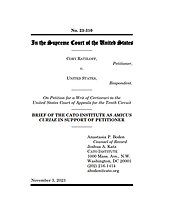How should federal courts treat the commentary to the Guidelines? In the 1993 case Stinson v. United States, the Supreme Court compared the question to administrative law, saying that the commentary should be treated in the same way as a government agency’s interpretation of its own regulations. Under the administrative law of the time, this meant that a very strong form of deference called Seminole Rock deference (later called Auer deference) would apply. Under Seminole Rock/Auer deference, the commentary’s interpretation of the Sentencing Guidelines would control unless it was “plainly erroneous.”
The Supreme Court has since clarified in the 2019 case Kisor v. Wilkie that Seminole Rock/Auer deference can only be applied in carefully limited and narrow circumstances, and six of the regional federal circuits have applied these safeguards to criminal sentencing. Yet six other circuits continue to reflexively give Seminole Rock/Auer deference to the Sentencing Guidelines commentary. Often, this means a defendant will receive a significantly harsher sentence—even when the commentary’s interpretation of the Guidelines is dubious and open to question.
Cory Ratzloff is one example. Ratzloff broke the window of a gun shop and stole firearms from a display case. He later pled guilty to the federal crime of stealing weapons from a federally licensed firearms dealer. But in addition to the penalty for this crime, Ratzloff faces a significant sentencing enhancement under the theory that by stealing a gun, he “used or possessed” a firearm in connection with another felony—burglary, which is a separate crime under state law.
Ratzloff argues that the guns he stole were simply the object of his burglary. Common sense suggests that stealing a gun is not the same thing as carrying or using a gun as a weapon of violence or intimidation to help facilitate other, unrelated crimes. But the Tenth Circuit felt bound to defer to the commentary to the Sentencing Guidelines, because the commentary—not the Guidelines themselves—say that the sentencing enhancement applies to Ratzloff’s actions. In the Tenth Circuit’s view, because the Supreme Court did not expressly say in Kisor that the safeguards on Seminole Rock/Auer deference apply in the sentencing context, the court must continue to reflexively defer to the commentary.
In our brief, we explain why the Supreme Court urgently needs to provide clarity on how Seminole Rock/Auer deference applies in the context of sentencing after Kisor explained its limitations. In addition, we ask the Court to clarify how federal courts should use the rule of lenity in analyzing sentencing rules. The rule of lenity is an ancient rule in the Anglo-American legal tradition, stating that when the meaning of a criminal law is ambiguous, all ambiguities should be resolved in favor of the defendant. The federal courts are divided on how to apply lenity when it comes to the sentencing Guidelines. Some courts hold that lenity takes precedence over any deference to the interpretations of government agencies. Other courts hold that deference to agency interpretations should apply first, and lenity should only enter the analysis afterwards if any traces of ambiguity remain. We argue that the Supreme Court should uphold the rule of lenity as taking priority over the unreviewable interpretations advanced by unelected government officials.


